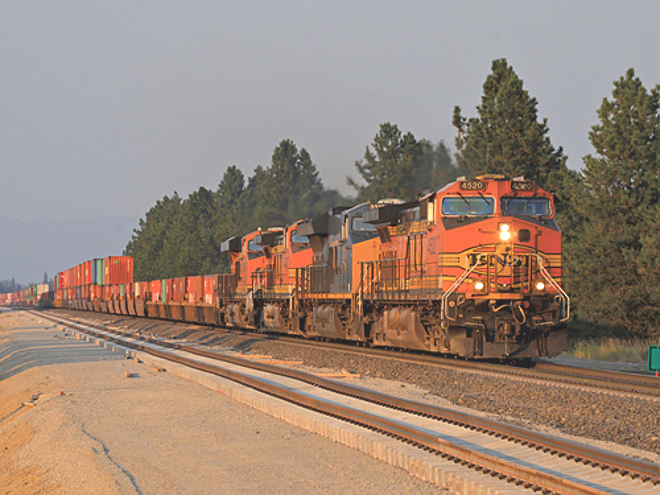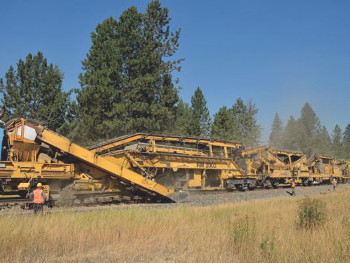|
BNSF, UP expanding, upgrading in northern Idaho |
|
September 26, 2017 |
 |
Story and Photos by Bruce E. Kelly
Railway Age
 |
| A UP
undercutter manufactured by Plasser
American cleans ballast on its way
northward through Elmira. |
Track projects this summer in North Idaho are
expanding capacity on a busy segment of
Burlington Northern Santa Fe’s Northern
Corridor, and upgrading conditions on Union
Pacific’s route to the Canadian border.
UP announced in June that it was “boosting
safety and efficiency with an approximately
$34.1 million infrastructure investment in Idaho
this year.”
In North Idaho, that investment has involved
$13.3 million to replace 29 miles of rail
(particularly in curves) from Athol north to
Eastport (where UP interchanges with Canadian
Pacific), $9.9 million to clean and replace
ballast between Athol and Naples, and $1.8
million to replace 8,265 ties between Athol and
Eastport.
Over the past three years, UP has also added
Centralized Traffic Control (CTC) to the south
end of its Spokane-Eastport line.
Dispatcher-controlled switches entered service
on a siding at Trentwood, Washington, in 2014,
and continuous CTC went live from CP Lee Street
in Spokane to CP035 in Garwood, Idaho, in 2016.
The remaining 104 miles from Garwood up the
Idaho panhandle to Eastport is currently “dark”
(un-signaled) track warrant territory, with the
exception of signals protecting movement over a
BNSF at-grade crossing in Sandpoint and a slide
fence zone north of Bonners Ferry.
UP plans to extend CTC northward from Garwood
and install two new sidings, one at Garwood, one
near Meadow Creek, in the near future.
BNSF has spent much of 2017 widening capacity
between Spokane and Sandpoint, an area that some
refer to as “The Funnel” because it channels
multiple main lines from the west and east onto
a single corridor.
Previous expansion was performed here in the
late 1990s when BNSF created nearly 40 miles of
dual main line on what had previously been a
mostly single-track railroad with sidings,
followed by the opening of BNSF’s run-through
refueling facility at Hauser Yard in 2004.
Director-Public Affairs Gus Melonas says, “BNSF
is making significant investments in 2017 to
reconfigure and add main line trackage with
improved train efficiency across the panhandle
as the goal.”
Those investments include adding three miles of
second main track between Athol and East Ramsey
and nearly six miles of second main track
between West Ramsey and Rathdrum, with the
siding at Ramsey being upgraded to main line
condition. In the photo at the top of the page,
BNSF rolls international containers westward
between Athol and Ramsey, past the newly-laid
second main.
Meanwhile, for the east end of Hauser Yard,
Melonas reports that BNSF employees are
converting an existing yard track into a third
main line into the Hauser fueling area, which is
expected to be complete by the end of September.
New switches have been installed, and a lead
track for the refueling facility has been
extended eastward.
Trains arriving or departing either the fuel pad
or the yard had to previously share a common
turnout off the main line, but there will now be
more capacity for independent, simultaneous
train movements in and out of East Hauser.
Completion of these projects will leave BNSF’s
68-mile Spokane-Sandpoint Funnel with three
short segments of single track totaling less
than ten miles.
“Future plans (date not determined officially)
could include adding double track from West
Algoma to Cocolalla, Idaho," Melonas said. "A
second bridge at Sandpoint will also be
constructed across Lake Pend Oreille, which will
allow for additional operations flexibility with
the convergence of the BNSF Hi Line and Montana
Rail Link lines.” |
|
Questions or comments about this
article?
Click here to e-mail! |
|
|
|
|

